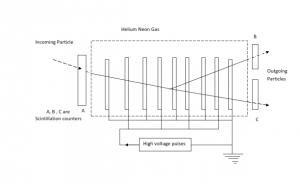Spark Chambers
The spark chamber is based on the simple fact that if the voltage across two metal plates separated by a distance of a few centimeters is increased beyond a certain value, a breakdown in the form of sparking occurs. The spark chamber consists of a series of thin parallel plates spaced a few millimeters apart, as shown Fig.
The first, third, fifth and all odd number plates are grounded and the second, fourth, sixth and all even number plates are connected to a high voltage source. In the figure there is one incoming particle giving rise to two charged particles. Three scintillation counters A,B and C detect the three charged particles. If the particles pass through these three counters, an electronic LOGIC circuit can be made to trigger the high voltage supply. It is possible to apply this pulse within a time interval of less than 50 nano sec, so that the resulting sparks can be photographically recorded. The track of this incoming particle is recorded and there is not much possibility of some background particle triggering off the spark track. In this way rare events and interations can be studied without the confusing or misleading background of unimportant.
Cherenkov Detectors
A Cherenkov detector is a particle detector using the speed threshold for light production, the speed-dependent light output or the velocity-dependent light direction of Cherenkov radiation. When the charged particle moves through water, it tends to “polarize” the water molecules in a direction adjacent to its path thus distorting the local electric charge distribution. Following thus, the molecules realign themselves in their original random charge distribution. A pulse of electromagnetic radiation in the form of blue light is emitted as a result of this reorientation. This radiation is called Cerenkov radiation after the name of Pavel Cerenkov who discovered it in 1934. When the speed of β particle is less than the speed of light, the pulses tend to cancel themselves by destructive interference. However, when the speed of particle is greater than the speed of light (in water) the pulses are amplified through constructive interference. The intensity of blue glow (called Cerenkov radiation) is directly proportional to the number of fissions occurring and the reactor power level. This property is utilized in Cerenkov detectors that measure the magnitude of Cerenkov radiation produced in a detector made of Lucite crystals. Cerenkov radiations become visible in the reactor core at a power of about 6 KW. At 200 kW the core glows soft blue. The blue glow persists for a shorts time after the reactor has been shut down. This persistence is due to the particles emitted by the decay of the fission products.


